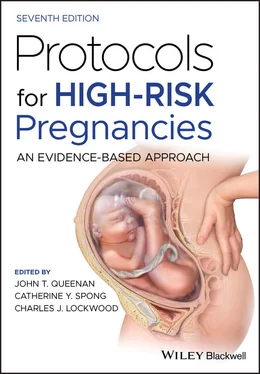Consequently, the modified BPP is reliable, easy to perform and can be utilized as a primary means of surveillance. The testing frequency should be at least once per week. In a setting of an AFI of less than 8 but greater than 5, a repeat evaluation of the amniotic fluid is recommended within 3–4 days.
The CST was historically the first method of fetal assessment using the noninvasive technique of fetal heart rate monitoring during the antepartum period. The test is based upon the fact that normal uterine contractions will restrict fetal oxygen delivery in a transient manner resulting from stasis of blood flow secondary to compression of maternal blood vessels in the uterine wall. Alterations in respiratory exchange in the maternal–fetal interface at the level of the placenta will result in differing responses of the fetus to interruption of maternal blood flow secondary to uterine contractions. If such contractions result in episodic fetal hypoxia, this will be demonstrated by the appearance of late decelerations of the fetal heart rate.
The CST is performed over a period of 30–40 minutes with the patient in the lateral recumbent position while both the fetal heart rate and uterine contractions are simultaneously recorded utilizing an external fetal monitor. A frequency of at least three 40‐second or longer contractions in a 10‐minute period of monitoring is required and these contractions can be either spontaneous or induced with nipple stimulation or resulting from the intravenous infusion of oxytocin.
The results of the CST are negative (no late or significant variable decelerations), positive (late decelerations following 50% or more of contractions), equivocal (intermittent late or significant variable decelerations or late decelerations following prolonged contractions of 90 seconds or more or with a contraction frequency of more than every two minutes), or unsatisfactory. A major problem associated with the CST is the high frequency of equivocal test results.
Relative contraindications to the CST are those conditions associated with a significant increased risk of preterm labor, preterm rupture of membranes, placenta previa with bleeding or history of classic cesarean delivery or extensive uterine surgery.
The CST has a remarkably low false‐negative rate of 0.04% (antepartum stillbirth within one week of a negative test) but up to 30% of positive tests when followed by induction of labor do not require intrapartum interventions for continued abnormalities of the fetal heart rate or adverse neonatal outcome. Because of the fact that the CST is more labor intensive, takes more time and has a high rate of equivocal test results, this test has generally been abandoned as the primary means of antepartum fetal surveillance. In some centers, the CST remains the primary test for women with type 1 diabetes. However, the CST remains a very reliable means of either primary or back‐up fetal surveillance for any number of high‐risk pregnancy conditions.
Umbilical Artery Doppler Velocimetry
In pregnancies complicated with suspected intrauterine growth restriction in the third trimester, umbilical artery Doppler velocimetry has been used either as an adjunct to or in lieu of fetal heart rate testing. Doppler ultrasound testing is a noninvasive procedure which is used to assess the presence and severity of resistance within the umbilical artery. This resistance is typically reduced, absent or reversed during diastole in growth‐restricted fetuses in comparison to equal gestational age but normally growing fetuses. This end‐diastolic flow is considered abnormal when it is either absent or reversed. The use of antepartum umbilical artery Doppler velocimetry has been shown to be of value but is limited to the management of pregnancies complicated with intrauterine growth restriction.
Indications for antepartum fetal surveillance
In general, the American College of Obstetricians and Gynecologists has recommended antepartum testing for specific maternal and fetal conditions. Such testing is intended to reduce the risk of stillbirth and has been generally accepted. However, it should be noted that the benefit of fetal surveillance testing of whatever form is based solely on observational studies which allowed clinical intervention. These studies have consistently suggested that stillbirth rates in tested populations of at‐risk patients are significantly lower than those in either untested low‐risk patients or similarly risked pregnancies managed without fetal surveillance testing.
There are a number of conditions associated with an increased risk of stillbirth for which fetal surveillance testing has been used routinely. Generally speaking, fetal surveillance testing is indicated in pregnancies complicated by conditions for which the stillbirth rate exceeds 0.8 per 1000 (which is the false‐negative rate for either a normal biophysical profile or a normal modified biophysical profile) and which also have an increased relative risk for stillbirth of more than twofold when compared with pregnancies without such conditions. However, the mechanisms responsible for the increased risk of stillbirth for a specific abnormal pregnancy condition are generally unknown. Further, the lack of prospective studies establishing a benefit of reduced stillbirth with fetal testing in the management of such complicated pregnancies makes it challenging to establish a specific list of all indications for which antepartum testing is indicated. This also applies to the timing of testing initiation during pregnancy and frequency of testing.
Newer examples of concerns for an increased risk of stillbirth but for which fetal surveillance testing has not previously been routinely recommended include conditions such as maternal obesity, advanced maternal age, pregnancy resulting from assisted reproductive techniques or pregnancies in women self‐reported as being black. While each of these conditions is a weak but potentially independent stillbirth risk factor, they are common and may present specific logistical, sociological, and systemic challenges if they are included as indications for antenatal fetal testing. Indeed, all indications for antepartum fetal testing should be considered as somewhat relative and may vary in significance among different providers. However, in general, the conditions for which fetal testing are recommended are listed below.
Maternal conditions: pregestational diabetes mellitus, hypertension, systemic lupus erythematosus, chronic renal disease, antiphospholipid syndrome, poorly controlled hyperthyroidism, hemoglobinopathy (such as sickle cell anemia, sickle‐hemoglobin C or sickle‐thalassemia disease), and cyanotic heart disease.
Pregnancy‐related conditions: preeclampsia, gestational hypertension, decreased fetal movement, oligohydramnios (deepest vertical pocket less than 2.0 cm), moderate or severe polyhydramnios (deepest vertical pocket 12.0 cm or greater or an AFI greater than 30.0 cm), intrauterine growth restriction, pregnancy at or beyond 41 completed weeks of gestation, isoimmunization, history of stillbirth, dichorionic twins with significant growth discrepancy or beyond 36 weeks’ gestation, monochorionic/diamniotic twins, premature rupture of membranes, and third‐trimester uterine bleeding.
Potential other indications: maternal age of 35 years or greater, obesity, maternal black race, suspected or confirmed fetal structural or genetic abnormalities, pregnancies conceived by in vitro fertilization, intrahepatic cholestasis of pregnancy, abnormal first‐ or second‐trimester serum analytes used in genetic risk assessment, abnormal umbilical cord findings such as vasa previa, single umbilical artery or velamentous cord insertion.
The following general factors apply to testing.
Читать дальше












